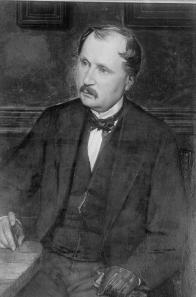- Alphonse Balat
Infobox Architect

name=Alphonse Hubert François Balat
nationality=Belgian,
birth_date=15 May 1818
birth_place=Gochenée,Belgium
death_date=16 September 1895
death_place=Ixelles ,Belgium
practice_name=
significant_buildings=Royal Greenhouses of Laeken Royal Palace of Belgium Royal Museums of Fine Arts of Belgium
significant_projects=
awards=Alphonse Hubert François Balat (Gochenée 1819 -
Ixelles 1895) was aBelgian architect .He studied at the Academie of Namur and obtained his degree in architecture from the Academy of
Antwerp in 1838.In 1839 he stayed in Paris for a year but returned after his fathers death. He was soon discovered by theWalloon nobility for which he built or renovated a number of 'Château 's' (amongst othersCastle of Jehay-Bodegnée ,Presles ). Stylistically these constructions often containedrenaissance elements with a neoclassical stress. In his interior designs he also used elements from theLouis XV andLouis XVI styles.In 1846 Balat settled in
Brussels . His was introduced to the Belgian royal family after he was noticed for his design of a temporary festive decoration for theSalle de la Madeleine (Magdalenamarkt) where the royal family had been present (1848).In 1851 and 1856 he created several temporary festive decorations for the monarchy. In 1852 he was appointed as the architect of theDuke of Brabant , the later kingLeopold II of Belgium . In 1856 he constructed the town palace (Hôtel) of the Marquess of Assche (Asse ) in the newly planned district called 'Quartier Léopold'. It was noticed for its austere classicalNeo-Renaissance facade inspired byMichelangelo 'sPalazzo Farnese inRome . His rather sober classical approach was rare at that time when excessively decorated facades and interiors were much preferred . During his career he built a large number of private residences. Most of them were demolished during the 20th century.After Leopold II ascended the throne in 1865, Balat became his principal architect. Balat made a number of designs for the sumptuous reception rooms of the palace such as the 'Throne Room', 'The Grand Staircase', and the 'Grande Galerie'. For this realisations he greatly followed the example of the French Royal residences. Balat realised the facade on the back of the palace and the facades of the courtyards. His design for the principal facade of the
Royal Palace of Belgium is deeply influenced by the work of the French architectAnge-Jacques Gabriel . It was not executed during Balat's lifetime and later completed in an altered form byHenri Maquet .His most successful architectural project are the
Royal Greenhouses of Laeken . It consists of a huge complex of several dome-shaped buildings in iron and glass that are connected by glass-roofed galleries. The centerpiece is the domed 'Grand Jardin d'hiver' which is a circular interpretation of thePalm House of theRoyal Botanic Gardens, Kew .Working with new materials like iron and glass, Balat was obliged to abandon his 'classical' stance. This stimulated the imagination of the architect. In the steel constructions he introduced decorative motifs derived from plants and flowers. This formed a first step towardsArt Nouveau architecture that was further devolopped byVictor Horta who served as an apprentice of Balat.Works
1. For
Leopold II of Belgium :
*Royal Palace of Belgium ,Brussels (1866-1874) : Grand Staircase, decoration of divers room, Throne Room, back facade, several projects for the principal facade.
*Royal Castle of Laeken : manège (1873-1874), new entrance gate (1879-1880), restoration after the fire (1890)
*Royal Greenhouses of Laeken (1874-1890)
*Royal Museums of Fine Arts of Belgium (1875-1880), rue de la Régence/Regentschapsstraat,Brussels .
* RoyalCastle of Ardenne (nearHouyet ), later converted into a luxury hotel. (1874-)
* RoyalCastle of Ciergnon (nearHouyet .
* Project for a 'Panthéon National', inKoekelberg (1880 - not realised), (colossal ionic temple)
* Facade of the RoyalCastle of Ciergnon (1880)
* Project for the 'Montagne de la Cour', today called 'Mont des Arts'/'Kunstberg' inBrussels (1882, not realised)2. For other private patrons:
* Transformations on theCastle of Jehay-Bodegnée
*Castle of Warfusée inSaint-Georges-sur-Meuse : facade inLouis XV style and interior decoration (1840)
* Château Saint-Marc, near Namur : facade
* Château deSeilles-lez-Andenne
* Castle ofHoutain-le-Val : exterior renovation.
* Château de Presles (1855)
* Gentilhommière à Dave (1858)
* Palace of Charles Vander Noot, Marquess of Assche, rue de la Science, 33 (today square Frère Orban)Brussels (1856-1858)
* Transformation of the Opheylissem abbey into a 'château de plaisance' (dome)(1870)
* Reconstruction of the Castle of Freyr after the fire (since 1875)
* Transformations on theCastle of Mirwart 3. Other projects:
* Festive decoration of the salle de la Madeleine inBrussels (1848)
* Festive decoration of the 'salle du palais ducal' inBrussels (1851) and (1856).
* 'Victoria Regia' greenhouse in the Zoo of Brussels (Leopold Park ). Moved to theNational Botanic Garden of Belgium inMeise . (Bouchout Castle )Bibliography
* Bordiau, G., "Notice sur Alphonse Balat", in "Annuaire de l'Académie Royale des Sciences des Lettres et des Beaux-Arts de Belgique", Brussels, 1903, pp. 129-148.
* Clément, J., "Alphonse Balat. Architecte du roi (1819-1895)", Palais des Académies, Brussels, 1956.
* Martiny, V.G., 'Balat, Alphonse' in "Biographie nationale"", Brussels, 1971, kol. 15-18.
* "Poelaert en zijn tijd"/"Poelaert et son temps" (exhib. cat.), Gemeentekrediet/Crédit communal, Brussels, 1980, pp. 199-209.
* Vandeweerdt, Dirk, "Kunstgeschiedenis, architectuur en beeldhouwkunst", deel 6 in "Culturele Geschiedenis van Vlaanderen", Baert, s.l., 1980.
* Goedleven, E., Fornari, B. en Vandenbreeden, J., "De Koninklijke Serres van Laken", Lannoo, Tielt, 1988.
* Smets, Irène, "De Koninklijke Serres te Laken", Ludion, Ghent, 2001.Persondata
NAME= Balat, Alphonse Hubert François
ALTERNATIVE NAMES=
SHORT DESCRIPTION=
DATE OF BIRTH=15 May 1818
PLACE OF BIRTH=Gochenée,Belgium
DATE OF DEATH=16 September 1895
PLACE OF DEATH=Ixelles ,Belgium
Wikimedia Foundation. 2010.
